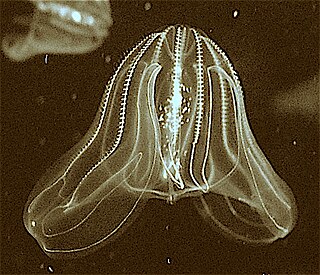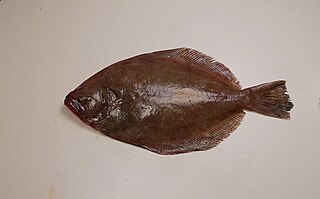
The Baltic Sea is a mediterranean sea of the Atlantic Ocean, enclosed by Denmark, Estonia, Finland, Latvia, Lithuania, Sweden, northeast Germany, Poland, Russia and the North and Central European Plain.

Brackish water is water having more salinity than freshwater, but not as much as seawater. It may result from mixing seawater with fresh water together, as in estuaries, or it may occur in brackish fossil aquifers. The word comes from the Middle Dutch root "brak". Certain human activities can produce brackish water, in particular civil engineering projects such as dikes and the flooding of coastal marshland to produce brackish water pools for freshwater prawn farming. Brackish water is also the primary waste product of the salinity gradient power process. Because brackish water is hostile to the growth of most terrestrial plant species, without appropriate management it is damaging to the environment.

The Atlantic cod is a benthopelagic fish of the family Gadidae, widely consumed by humans. It is also commercially known as cod or codling. Dry cod may be prepared as unsalted stockfish, as cured salt cod or clipfish.

Flounders are a group of flatfish species. They are demersal fish, found at the bottom of oceans around the world; some species will also enter estuaries.

A flatfish is a member of the ray-finned demersal fish order Pleuronectiformes, also called the Heterosomata, sometimes classified as a suborder of Perciformes. In many species, both eyes lie on one side of the head, one or the other migrating through or around the head during development. Some species face their left sides upward, some face their right sides upward, and others face either side upward.

The Skagerrak is a strait running between the southeast coast of Norway, the west coast of Sweden, and the Jutland peninsula of Denmark, connecting the North Sea and the Kattegat sea area, which leads to the Baltic Sea.

Sprat is the common name applied to a group of forage fish belonging to the genus Sprattus in the family Clupeidae. The term also is applied to a number of other small sprat-like forage fish. Like most forage fishes, sprats are highly active, small, oily fish. They travel in large schools with other fish and swim continuously throughout the day.

The sea lamprey is a parasitic lamprey native to the Northern Hemisphere.

The round goby is a euryhaline bottom-dwelling goby of the family Gobiidae, native to central Eurasia including the Black Sea and the Caspian Sea. Round gobies have established large non-native populations in the Baltic Sea, several major Eurasian rivers, and the North American Great Lakes.

Carcinus maenas is a common littoral crab. It is known by different names around the world. In the British Isles, it is generally referred to as the shore crab, or green shore crab. In North America and South Africa, it bears the name green crab or European green crab. In Australia and New Zealand, it is referred to as either the European green crab or European shore crab.

Mnemiopsis leidyi, the warty comb jelly or sea walnut, is a species of tentaculate ctenophore. It is native to western Atlantic coastal waters, but has become established as an invasive species in European and western Asian regions. Three species have been named in the genus Mnemiopsis, but they are now believed to be different ecological forms of a single species M. leidyi by most zoologists.

The yellowbelly flounder is a flatfish of the genus Rhombosolea, found around New Zealand. A different species from the genus Rhombosolea is found in Australia and also goes by the name yellow-belly flounder. The Māori people have commonly fished for R.leporina, and many other species of flatfish, throughout New Zealand's coastal waters for hundreds of years. The Māori name for this species is 'patiki totara'.

The Japanese eel is a species of anguillid eel found in Japan, Korea, China, Taiwan, and Vietnam, as well as the northern Philippines. Like all the eels of the genus Anguilla and the family Anguillidae, it is catadromous, meaning it spawns in the sea, but lives parts of its life in fresh water. The spawning area of this species is in the North Equatorial Current in the western North Pacific to the west of the Mariana Islands. The larvae are called leptocephali and are carried westward by the North Equatorial Current and then northward by the Kuroshio Current to East Asia, where they live in rivers, lakes, and estuaries. The Japanese eel is an important food fish in East Asia, where it is raised in aquaculture ponds in most countries in the region. In Japan, where they are called unagi, they are an important part of the food culture, with many restaurants serving grilled eel, which is called kabayaki. Eels also have uses in Chinese medicine.

The Spanish toothcarp, also known as the Spanish pupfish or Iberian killifish, is a small, endemic species of fish in the family Cyprinodontidae. Its risk of extinction is one of the greatest of any Iberian vertebrate. Its limited range, coupled with the drastic population decline the species has suffered in the last two decades, has caused it to be placed on endangered species lists, both in Spain and internationally. Its conservation status in the south of the Iberian peninsula has notably worsened.

The European flounder is a flatfish of European coastal waters from the White Sea in the north to the Mediterranean and the Black Sea in the south. It has been introduced into the United States and Canada accidentally through transport in ballast water. It is caught and used for human consumption.

The European anchovy is a forage fish somewhat related to the herring. It is a type of anchovy; anchovies are placed in the family Engraulidae. It lives off the coasts of Europe and Africa, including in the Mediterranean Sea, the Black Sea, and the Sea of Azov. It is fished by humans throughout much of its range.

Paralichthys lethostigma, the southern flounder, is a species of large-tooth flounders native to the eastern and gulf coasts of the United States. It is a popular sports fish and is the largest and most commercially valuable flounder in the western North Atlantic Ocean and Gulf of Mexico. It is a "left-eyed flounder", meaning the left side is pigmented and is the "up side".

Platichthys is a genus of flatfish native to the North Pacific and North Atlantic oceans. Despite being in the family Pleuronectidae, all three species in the genus Platichthys are often "lefteyed", i.e. they lie on the sea bottom on their right side, with both eyes on the left side.

Dikerogammarus villosus, also known as the killer shrimp, is a species of amphipod crustacean native to the Ponto-Caspian region of eastern Europe, but which has become invasive across the western part of the continent. In the areas it has invaded, it lives in a wide range of habitats and will kill many other animals, often not eating them. It is fast-growing, reaching sexual maturity in 4–8 weeks. As it has moved through Europe it threatens other species and has already displaced native amphipods as well as other amphipods which had invaded areas previously.

Fucus radicans is a species of brown algae in the family Fucaceae, endemic to and recently evolved within the Baltic Sea. The species was first described by Lena Bergström and Lena Kautsky in 2005 from a location in Ångermanland, Sweden. The specific epithet is from the Latin and means "rooting", referring to the fact that this species primarily reproduces by the taking root of detached fragments.



















